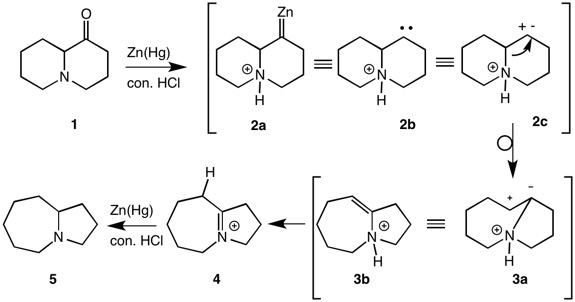Orthocresol is correct. The mechanism of the Clemmensen Reduction is enigmatic. Leonard and co-authors provided a 1949-type mechanism where hydride or zinc-nascent hydrogens was the reducing agents of the carbocation while not addressing the issue that the amine is totally protonated in conc. HCl (pKa H3O+ ~-1.7; pKa "NH4+" 9.3]. The nitrogen electron pair is not available as described by Leonard. Orthocresol has provided both prevailing options for the Clemmensen Reduction. I'll focus on the carbenoid route. Structures 2 are three ways of thinking
about a carbene for mechanistic purposes: metal bound 2a, electron pair 2b and vacant and filled orbitals 2c. Bond migration in 2c affords 3a, which is equivalent to a nitrogen protonated enamine 3b. However, enamines1,2 such as 1-pyrrolidino cyclohexene undergo facile hydrolysis in aqueous acid. This means that C-protonation occurs to give an immonium salt and, if N-protonation occurs, it is reversible. Given an N-protonated enamine here, isomerization to the immonium salt 4 is expected followed by a 2-electron reduction to afford the tertiary amine 5.
- In MemoriumMemoriam: Professor Gilbert Stork (1921-2017)
- Stork, G., et al., J. Am. Chem. Soc., 1963, 85, 207. http://pubs.acs.org/doi/abs/10.1021/ja00885a021

